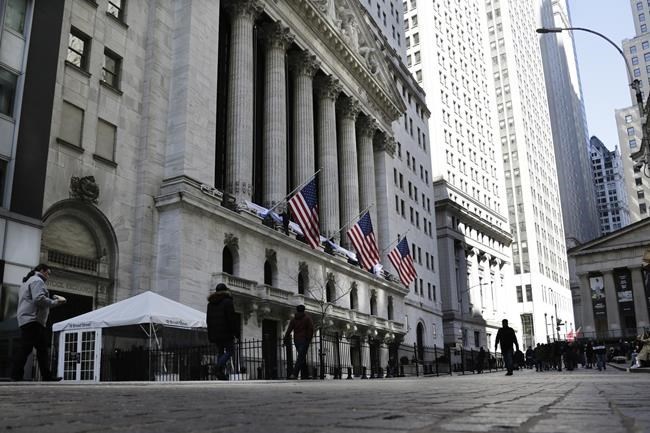NEW YORK (AP) — Wall Street ticked mostly higher as investors consider both the upsides and downsides of the U.S. economy remaining stronger than feared. The S&P 500 rose 0.4% Thursday after wobbling between small gains and losses. The Dow added 0.8% and the Nasdaq ended just barely lower, less than 0.1%. Yields jumped after data showed the U.S. economy grew faster at the year’s start than estimated. Fewer workers applied for unemployment benefits last week. The data are a positive for investors because they suggest a growing economy can support corporate profits. They could also mean higher interest rates, however.
THIS IS A BREAKING NEWS UPDATE. AP’s earlier story follows below.
NEW YORK (AP) — Wall Street is ticking higher Thursday as investors consider both the upsides and downsides of the latest signals that the U.S. economy remains stronger than feared.
The S&P 500 was 0.3% higher in afternoon trading after wobbling between small gains and losses. The Dow Jones Industrial Average was up 215 points, or 0.6%, at 34,068 as of 3 p.m. Eastern time, and the Nasdaq composite slipped 0.2%.
Yields were jumping in the bond market after data showed the U.S. economy grew at a 2% annual rate in the first three months of the year, much stronger than the 1.3% rate earlier estimated. Another report said fewer workers applied for unemployment benefits last week than expected, a sign that the job market remains remarkably solid despite much higher interest rates meant to slow the overall economy.
“The US economy is currently displaying genuine signs of resilience,” said Gregory Daco, chief economist at EY. “This is leading many to rightly question whether the long-forecast recession is truly inevitable.”
On one hand, the data are a positive for investors because they suggest the economy can keep growing and support profits for companies, which are the lifeblood of the stock market. But on the other, they could also mean the Federal Reserve will see the economy as strong enough to keep hiking interest rates to drive down inflation.
The Fed has pulled rates higher at a blistering pace since early last year. High rates slow inflation by dragging on the entire economy, and they have already hurt the manufacturing and other industries while helping to cause three high-profile failures in the U.S. banking system.
Thursday’s data pushed up expectations among traders for the Fed to raise rates twice more this year, according to data from CME Group. That’s what the Fed has been suggesting it would do, but Wall Street has been slow to accept it. Earlier, it had been mostly penciling in just one increase.
The shift helped drive the two-year Treasury yield up to 4.89% from 4.71% late Wednesday. It tends to track expectations for Fed action.
The 10-year yield rose to 3.85% from 3.71%. It helps set rates for mortgages and other important loans.
In the stock market, banks were rising to some of the biggest gains. Wells Fargo rose 4.4%, M&T Bank gained 2.1% and JPMorgan Chase climbed 3.3%.
The Federal Reserve said late Wednesday that the nation’s 23 largest banks would be able to survive a severe recession in its latest “stress test” of the system. Failing the test would have restricted banks from paying dividends or buying back their own stock to send cash to shareholders.
A stronger economy could also help banks make more money from making loans, though higher interest rates could also pressure their balance sheets.
Fed Reserve Chair Jerome Powell warned Thursday the central bank may have to tighten regulation of the system after several banks collapsed when rising rates knocked down the value of bonds they bought and other investments made when rates were ultralow.
Much scrutiny has been on smaller and mid-sized banks as Wall Street hunts for the next potential weak links in the system. Several rose Thursday to trim their big losses from earlier this year. PacWest Bancorp gained 3.4%, for example.
Rite Aid rose 4% after reporting much stronger profit for the latest quarter than analysts expected.
On the losing end of Wall Street was Micron Technology. It fell 3.9% for one of the biggest declines in the S&P 500 after forecasting a larger loss for the summer than analysts expected. That was despite the memory and storage company reporting stronger results for the latest quarter than expected. Micron also said it thinks the bottom has passed for the chip industry’s revenue, and it expects profit margins to improve.
Spices company McCormick fell 4.9% after reporting weaker revenue for the latest quarter than expected, though its profit topped expectations. It also raised its forecasted range for profits this year, but only the top end of the range for earnings per share matched analysts' expectations.
In markets abroad, indexes ended mixed. Stocks fell 1.2% in Shanghai and 0.6% in South Korea, while rising 0.4% in France and 0.1% in Japan.
——
AP Business Writers Matt Ott, Joe McDonald and Alex Veiga contributed.
Stan Choe, The Associated Press



